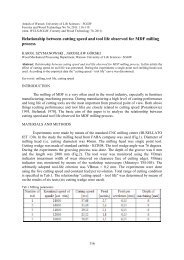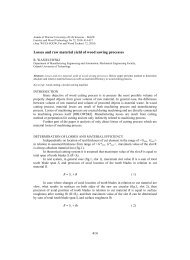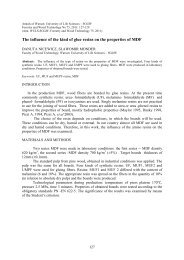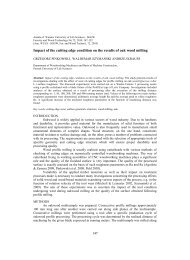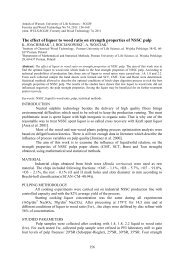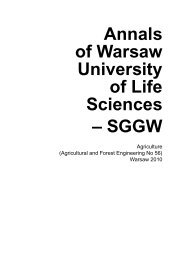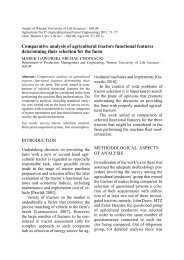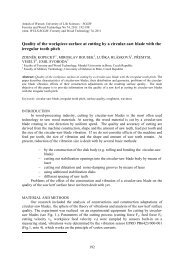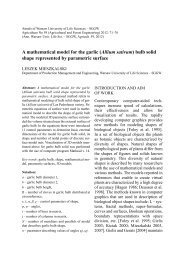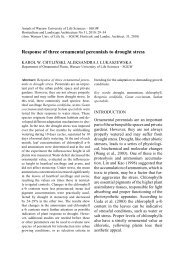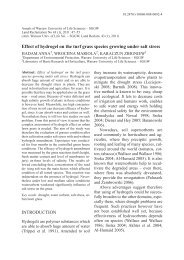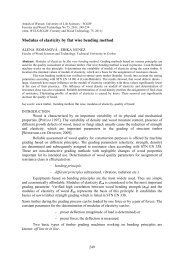- Page 1 and 2: Contents: Annals of Warsaw Universi
- Page 3 and 4: �������� ���
- Page 5 and 6: JANDA�KA JOZEF, NOSEK RADOVAN, PA
- Page 7 and 8: KUROWSKA AGNIESZKA, KOZAKIEWICZ PAW
- Page 9 and 10: Annals of Warsaw University of Life
- Page 11 and 12: Conditions of FT-IR analysis and de
- Page 13: 8. D. KRUTUL, Charakterystyka celul
- Page 17 and 18: In Fig. 2, 3, 4 relationship betwee
- Page 19 and 20: 2. Results obtained for cellulose w
- Page 21 and 22: of the panels from fibrous chips su
- Page 23 and 24: Streszczenie: Mo�liwo�ci oraz o
- Page 25 and 26: ��������� 0,011
- Page 27 and 28: 2. �������� ��
- Page 29 and 30: compared to previous year reached o
- Page 31 and 32: Annals of Warsaw University of Life
- Page 33 and 34: Table 1. Wood and wood and cork pro
- Page 35 and 36: Analysis of the results of table 4
- Page 37 and 38: Annals of Warsaw University of Life
- Page 39 and 40: and the angle � is directed count
- Page 41 and 42: Streszczenie: Rozk�ad napr��e
- Page 43 and 44: 5. ����������
- Page 45 and 46: ��������� ��
- Page 47 and 48: Annals of Warsaw University of Live
- Page 49 and 50: The first ageing cycles had the big
- Page 51 and 52: Annals of Warsaw University of Life
- Page 53 and 54: observatuion (R 2 = 0,9882 for bioc
- Page 55 and 56: 13. SELKE S E and WACHMAN I (2004):
- Page 57 and 58: Table 1. Veneers’ preservation va
- Page 59 and 60: Shear strength [N/mm 2 ] 3,5 3,0 2,
- Page 61 and 62: 7. JAB�O�SKI M., OSIPIUK J., DO
- Page 63 and 64: Table 1. Board manufacturing parame
- Page 65 and 66:
Analyzing the thickness swelling an
- Page 67 and 68:
Annals of Warsaw University of Life
- Page 69 and 70:
������� 3. ���
- Page 71 and 72:
kc specific surface cutting resista
- Page 73 and 74:
� y �� � S t �t 0 R � S
- Page 75 and 76:
Annals of Warsaw University of Life
- Page 77 and 78:
Camera Target Beam divider Light so
- Page 79 and 80:
Annals of Warsaw University of Life
- Page 81 and 82:
evaluation of rigidity. However, af
- Page 83 and 84:
Annals of Warsaw University of Life
- Page 85 and 86:
Table 2. The influence of density o
- Page 87 and 88:
Annals of Warsaw University of Life
- Page 89 and 90:
Fig.2. Wear curves for tool 1 and 2
- Page 91 and 92:
korelacyjne mi�dzy parami czynnik
- Page 93 and 94:
RESULTS The changes in pressing par
- Page 95 and 96:
The obtained IB and thickness swell
- Page 97 and 98:
Annals of Warsaw University of Life
- Page 99 and 100:
Norway spruce Tab. 2 Physical and a
- Page 101 and 102:
Annals of Warsaw University of Life
- Page 103 and 104:
������ �����
- Page 105 and 106:
Acknowledgement: This work was supp
- Page 107 and 108:
12 � 6150, 6 � p ��� �
- Page 109 and 110:
Acknowledgement: This work was supp
- Page 111 and 112:
MAGNETISCHE SÄGEBLATTFÜHUNG; THEO
- Page 113 and 114:
3. DIETZ H., 2003: Der Markt verlan
- Page 115 and 116:
Nach Sturm [1738] Tab. XXXIII. biß
- Page 117 and 118:
hat. Je grösser nun der Radius, di
- Page 119 and 120:
gerichtet und von einem Ort an den
- Page 121 and 122:
man den Schlitten nicht also zurich
- Page 123 and 124:
dieses ist der rechte Preiß, wodur
- Page 125 and 126:
Sk�adamy serdeczne podzi�kowani
- Page 127 and 128:
MATERIALS AND METHODS For mutual co
- Page 129 and 130:
height. However, it is positive and
- Page 131 and 132:
Dust particles contents [pcs./m 3 ]
- Page 133 and 134:
Streszczenie: Wst�pne badania prz
- Page 135 and 136:
Fig. 2. Surface of filtering bag; A
- Page 137 and 138:
CONCLUSION On the ground of receive
- Page 139 and 140:
Mass share [%] 18 16 14 12 10 8 6 4
- Page 141 and 142:
REFERENCES [1] S. DOLNY, 1999, Tran
- Page 143 and 144:
the ability to achieve the desired
- Page 145 and 146:
Final evaluation of the economic ef
- Page 147 and 148:
Annals of Warsaw University of Life
- Page 149 and 150:
yield % 45 38 31 24 17 10 1 2 3 4 5
- Page 151 and 152:
CONCLUSIONS - Cellulose with the op
- Page 153 and 154:
with a silica sol in the manufactur
- Page 155 and 156:
Values of fm and Em obtained for pl
- Page 157 and 158:
Annals of Warsaw University of Life
- Page 159 and 160:
The experimental plywood was made f
- Page 161 and 162:
not exceed 50 per cent. However, si
- Page 163 and 164:
19 and 16 s/mm board thickness, pre
- Page 165 and 166:
the amount of PMDI introduced to ur
- Page 167 and 168:
Undoubtedly strength of low-density
- Page 169 and 170:
earing particleboards (type P4). Th
- Page 171 and 172:
The influence of ultrastructure of
- Page 173 and 174:
MFA [deg] MFA [deg] MFA [deg] 16 14
- Page 175 and 176:
and mean MFA, observed even in a sm
- Page 177 and 178:
Annals of Warsaw Agricultural Unive
- Page 179 and 180:
The virulence of strains of mould f
- Page 181 and 182:
7. Rep G., Pohleven F., Bucar B., 2
- Page 183 and 184:
during 14 or 20 minutes. After pres
- Page 185 and 186:
The influence of used adhesive on s
- Page 187 and 188:
Annals of Warsaw University of Life
- Page 189 and 190:
In the third step we analyze result
- Page 191 and 192:
Fig. 5 The relation of power and de
- Page 193 and 194:
LITERATURE 1. GAFF, M. 2009: Analys
- Page 195 and 196:
- �����������
- Page 197 and 198:
���. 2. �������
- Page 199 and 200:
Annals of Warsaw University of Life
- Page 201 and 202:
a) Tensile modulus (MPa) c) Tensile
- Page 203 and 204:
Annals of Warsaw University of Life
- Page 205 and 206:
causes the growth of impact strengt
- Page 207 and 208:
Annals of Warsaw University of Life
- Page 209 and 210:
RESULTS AND DISCUSION The results o
- Page 211 and 212:
Annals of Warsaw University of Life
- Page 213 and 214:
RESULTS AND DISCUSION Upper line Ca
- Page 215 and 216:
Basically, two main kinds of defect
- Page 217 and 218:
Annals of Warsaw University of Life
- Page 219 and 220:
Characteristcs before any exposure
- Page 221 and 222:
Annals of Warsaw University of Life
- Page 223 and 224:
time unit and temperature in specif
- Page 225 and 226:
Annals of Warsaw University of Life
- Page 227 and 228:
temperature [C] 600,0 500,0 400,0 3
- Page 229 and 230:
Annals of Warsaw University of Life
- Page 231 and 232:
of the samples showed particleboard
- Page 233 and 234:
Fig.6. ���������
- Page 235 and 236:
Annals of Warsaw University of Life
- Page 237 and 238:
elasticity (MOE) and modulus of rup
- Page 239 and 240:
ROZMAN H. D., AHMADHILMI K. R., ABU
- Page 241 and 242:
Oak (Quercus L.) • Ship building,
- Page 243 and 244:
Purple smoke bush (Cotinus coggygri
- Page 245 and 246:
Annals of Warsaw University of Life
- Page 247 and 248:
From the measured lapses is seen su
- Page 249 and 250:
13. HORÁK, J. Vytáp�ní tuhými
- Page 251 and 252:
either heat conduction or by gravit
- Page 253 and 254:
To transform heat into electricity
- Page 255 and 256:
Annals of Warsaw University of Life
- Page 257 and 258:
Experimental production Each input
- Page 259 and 260:
1600 1550 1500 1450 1400 1350 1300
- Page 261 and 262:
Annals of Warsaw University of Life
- Page 263 and 264:
Fig.5. Measured profiles of heat po
- Page 265 and 266:
Annals of Warsaw University of Life
- Page 267 and 268:
Fig.2. The experimental boiler RESU
- Page 269 and 270:
Bed’, Presented at the Nordic Sem
- Page 271 and 272:
Discoloration analysis was based on
- Page 273 and 274:
Total color difference 14 12 10 8 6
- Page 275 and 276:
Annals of Warsaw University of Live
- Page 277 and 278:
climate (typical for the territory
- Page 279 and 280:
16. MATEJAK M., �WIETLICZNY M., 1
- Page 281 and 282:
temperature increase phase was 0.25
- Page 283 and 284:
Table 2. Color parameters of therma
- Page 285 and 286:
Annals of Warsaw University of Life
- Page 287 and 288:
Fig. 3b. Specific emission CO2 for
- Page 289 and 290:
Fig. 5b. Specific emission CO2 for
- Page 291 and 292:
Annals of Warsaw University of Life
- Page 293 and 294:
Fig. 3. Specific emission CO2 for p
- Page 295 and 296:
REFERENCES 1. BAYSAL E., YALINKILIC
- Page 297 and 298:
influence of thermal conduction in
- Page 299 and 300:
4. BRYDEN K.M., RAGLAND K.W., RUTLA
- Page 301 and 302:
In this study, experiments were car
- Page 303 and 304:
7. LEBECKI K., DYDUCH Z., FIBICH A.
- Page 305 and 306:
der thermoplastischen Kunststoffe i
- Page 307 and 308:
Bild 5. Quellung der OSB-Platte mod
- Page 309 and 310:
Annals of Warsaw University of Life
- Page 311 and 312:
a) b) c) d) 311
- Page 313 and 314:
(2005) 63: 380-387 5. Marutzky R.:
- Page 315 and 316:
Before placing the samples in the g
- Page 317 and 318:
Ryc.1 Resistance to infestation of
- Page 319 and 320:
Annals of Warsaw University of Life
- Page 321 and 322:
wearing. In interval angles of incl
- Page 323 and 324:
Annals of Warsaw University of Life
- Page 325 and 326:
Fig. 4 Influence of wood sample’s
- Page 327 and 328:
The contribution was created during
- Page 329 and 330:
a woody plant on which a symmetrica
- Page 331 and 332:
strength were found at breast heigh
- Page 333 and 334:
also observed that the trend for wo
- Page 335 and 336:
Streszczenie: Biomechanika drzew so
- Page 337 and 338:
species, sites as well as age level
- Page 339 and 340:
Table 1 Correlation coefficients fo
- Page 341 and 342:
Streszczenie: Dynamika procesu twar
- Page 343 and 344:
RESEARCH RESULTS AND DISCUSSION The
- Page 345 and 346:
Time [s] 360 320 280 240 200 160 12
- Page 347 and 348:
Annals of Warsaw University of Life
- Page 349 and 350:
Table 1. Results of coating assessm
- Page 351 and 352:
Annals of Warsaw University of Life
- Page 353 and 354:
������, �����
- Page 355 and 356:
Annals of Warsaw University of Life
- Page 357 and 358:
Despite methods of forest an farmin
- Page 359 and 360:
REFERENCES 1. Drozd L., Florek M.,
- Page 361 and 362:
Noise-elimination grooves demonstra
- Page 363 and 364:
the noise level of 85 dB. Already a
- Page 365 and 366:
These findings correspond well with
- Page 367 and 368:
Annals of Warsaw University of Life
- Page 369 and 370:
The temperature conductivity coeffi
- Page 371 and 372:
Annals of Warsaw University of Life
- Page 373 and 374:
Table 1. The linear regression equa
- Page 375 and 376:
c) conditioning over saturated MgCl
- Page 377 and 378:
5. KOHARA J., OKAMOTO H., 1955: Stu
- Page 379 and 380:
Bild. 2. Eine Kreissäge mit Handbe
- Page 381 and 382:
Bild 5. Eine kleine Maschine zum sc
- Page 383 and 384:
Annals of Warsaw University of Life
- Page 385 and 386:
11. Der Ausschieb-Nagel, ist im Wag
- Page 387 and 388:
LITERATURVERZEICHNIS GOTTLIEB JÖCH
- Page 389 and 390:
und jeder bey gesagten Machinen vor
- Page 391 and 392:
Der nächste Künstler, der seine l
- Page 393 and 394:
Weiter gibt es Kopfzerbrechen und L
- Page 395 and 396:
Annals of Warsaw University if Life
- Page 397 and 398:
DISCUSSION Attention is paid to rel
- Page 399 and 400:
egzotycznym drewnem do polski s�
- Page 401 and 402:
Table 1. The species of wood constr
- Page 403 and 404:
ia�� jako deski wewn�trznej w
- Page 405 and 406:
at a distance of about 2m from the
- Page 407 and 408:
Fig.2. The modulus of elasticity vs
- Page 409 and 410:
10. KRAUSS A., FABISIAK E., SZYM�
- Page 411 and 412:
MATERIALS AND METHODS Samples were
- Page 413 and 414:
cellulose content/ % cellulose cont
- Page 415 and 416:
REFERENCES 1. ASH C. P. J., LEE D.
- Page 417 and 418:
Annals of Warsaw University of Life
- Page 419 and 420:
high temperature. This parameter lo
- Page 421 and 422:
Annals of Warsaw University of Life
- Page 423 and 424:
Results of investigations of the re
- Page 425 and 426:
Annals of Warsaw University of Life
- Page 427 and 428:
Tabelle 2. Mittelwerte vom Elastizi
- Page 429 and 430:
Annals of Warsaw University of Life
- Page 431 and 432:
meranti will not comply with the mi
- Page 433 and 434:
shear strength is density and moist
- Page 435 and 436:
Annals of Warsaw University of Life
- Page 437 and 438:
g, so with given dimensions of heig
- Page 439 and 440:
Sztuki Akademii Sztuk Pi�knych w
- Page 441 and 442:
���. 1. �������
- Page 443 and 444:
���������� �
- Page 445 and 446:
���. 1. ������-
- Page 447 and 448:
���.5. �������
- Page 449 and 450:
Streszczenie: Wp�yw w�a�ciwo
- Page 451 and 452:
EXPERIMENTS Preparation of the subs
- Page 453 and 454:
3. NEBIOGLU A., SOUCEK M.D., 2006:
- Page 455 and 456:
RESULTS Results of the adherence of
- Page 457 and 458:
Przemys�owe. Uszlachetnianie powi
- Page 459 and 460:
Table 1. Kind of cold liquids used
- Page 461 and 462:
It was stated, that on obtained res
- Page 463 and 464:
the chromatographic syringe in the
- Page 465 and 466:
CONCLUSIONS 1. On the basis of crit
- Page 467 and 468:
Annals of Warsaw University of Life
- Page 469 and 470:
* * * �� � � xx � Q11 Q12
- Page 471 and 472:
Figure 3. Laminate deformations and
- Page 473 and 474:
Annals of Warsaw University of Life
- Page 475 and 476:
RESULTS OF NUMERICAL ANALYSIS For t
- Page 477 and 478:
Tab. 2.2. Results of numerical anal
- Page 479 and 480:
Annals of Warsaw University of Life
- Page 481 and 482:
Mass spectrum Fig.2 Mass spectrum o
- Page 483 and 484:
Attempts to laboratory synthesis of
- Page 485 and 486:
O * O O * H O O O O * O O * + O O F
- Page 487 and 488:
Polydispersity, D 6 5 4 0 10 20 30
- Page 489 and 490:
Streszczenie: Termiczne i fotolityc
- Page 491 and 492:
It was stated that a single drop we
- Page 493 and 494:
Additionally, the highest content o
- Page 495 and 496:
Annals of Warsaw University of Life
- Page 497 and 498:
�����������
- Page 499 and 500:
Annals of Warsaw University of Life
- Page 501 and 502:
was observed only under specific ac
- Page 503 and 504:
6. SEDLIA�IK, J., ŠMIDRIAKOVÁ,
- Page 505 and 506:
were marked as MA, MO, BA, BO. Samp
- Page 507 and 508:
Fig.2. Microfungal growth of pine a
- Page 509 and 510:
Annals of Warsaw University of Life
- Page 511 and 512:
paper and printing 18 957 18 611 30
- Page 513 and 514:
It is estimated that fulfilling the
- Page 515 and 516:
Annals of Warsaw University of Life
- Page 517 and 518:
Bending strength of OSB Type of boa



